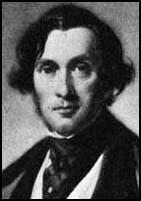Joseph Locke

Joseph Locke was born in Attercliffe, near Sheffield in 1805. He left school at 13 and after various jobs became an apprentice under George Stephenson in 1823. Locke worked with Stephenson on the building of the Stockton & Darlington Railway and the Liverpool & Manchester Railway. Locke's reputation grew and he was appointed with Stephenson as joint chief engineer of the Grand Junction Railway. Stephenson, who did not find it easy to share power with his former pupil and in 1835 decided to leave the project.
The Grand Junction Railway, opened on 20th July, 1837, was over eighty-two miles long and linked Birmingham with the Liverpool & Manchester line.The line included 100 underbridges, 50 overbridges, 5 viaducts, 2 tunnels and 2 aqueducts. On some parts of the line, Joseph Locke used double-headed rails held in chairs mounted on wooden sleepers. This proved to be very successful and this became the usual form of track on British railways for many years.
Locke developed a reputation for building straight railway lines that avoided expensive tunnelling. In doing so, he was forced in some places to adopt gradients that were too steep for economical running. However, he was the first railway engineer that realised that locomotives would gradually be able to overcome steep gradients. By the 1840s improved locomotives meant that Locke was able to build railway lines with gradients as steep as 1 in 50.
Locke's success building the Grand Junction Railway resulted in him being offered commissions to build railways all over Europe, notably, the railway between Paris and Rouen. Joseph Locke died in 1860.
